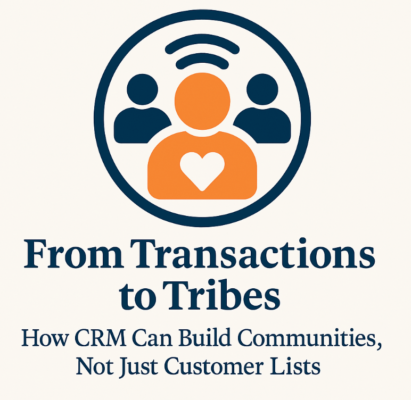
Customer Relationship Management (CRM) has traditionally been seen as a tool for tracking customer interactions, analyzing data, and driving sales. However, in an era where customers seek more than just products, CRM must evolve beyond managing transactions—it must foster genuine communities. By shifting the focus from mere customer lists to engaged tribes, businesses can build long-term loyalty, advocacy, and a deeper sense of belonging among their customers.
The Shift from Customers to Communities
The digital age has changed how people connect with brands. Customers are no longer just looking for products or services; they seek experiences, values, and shared identities. CRM systems, when used strategically, can transform customers into loyal community members who actively engage with a brand, advocate for it, and even contribute to its growth. This transition requires businesses to rethink their CRM strategies, prioritizing engagement, conversation, and shared purpose over simple sales metrics.
Personalization as the Foundation of Community Building
Traditional CRM focuses on personalizing marketing efforts based on purchasing habits and demographic data. However, fostering a community requires deeper personalization—understanding customers’ interests, values, and motivations. Advanced CRM tools powered by AI and machine learning can help segment customers not just by past purchases but by shared behaviors, values, and engagement levels. By leveraging this data, businesses can create highly targeted experiences that make customers feel seen and valued as part of a tribe.
Engagement Beyond Sales: Creating Meaningful Interactions
Communities thrive on engagement, not just transactions. Businesses that use CRM to facilitate meaningful interactions—such as exclusive forums, loyalty programs, or interactive content—can cultivate deeper relationships. Some strategies include:
- Exclusive Memberships: Offering VIP experiences or access to a members-only community fosters a sense of belonging.
- User-Generated Content: Encouraging customers to share their experiences, stories, and feedback strengthens community bonds.
- Social Listening: Monitoring and engaging in customer conversations on social media helps brands respond in real-time and build rapport.
- Event-Based Engagement: Hosting webinars, Q&A sessions, or live meetups helps create personal connections beyond digital interactions.
The Power of Advocacy: Turning Customers into Brand Ambassadors
A strong community naturally creates brand advocates—customers who promote the brand because they believe in it, not just because of incentives. CRM can help identify and nurture these brand ambassadors by tracking customer sentiment, engagement levels, and social influence. Recognizing and rewarding loyal community members through exclusive perks, shout-outs, or referral programs can further solidify these relationships and amplify word-of-mouth marketing.
CRM and Emotional Connection: The Key to Long-Term Loyalty
Customers who feel emotionally connected to a brand are more likely to stay loyal and recommend it to others. CRM can facilitate these emotional connections by tracking not just interactions but sentiment and satisfaction. Advanced analytics, sentiment analysis, and AI-driven insights can help businesses proactively address concerns, celebrate milestones, and create personalized experiences that make customers feel valued.
Conclusion
The future of CRM lies in building communities, not just maintaining customer lists. By focusing on personalization, meaningful engagement, and emotional connections, businesses can transform passive customers into active tribe members who contribute to the brand’s success. In doing so, companies move beyond transactions and create lasting relationships that drive both loyalty and advocacy.